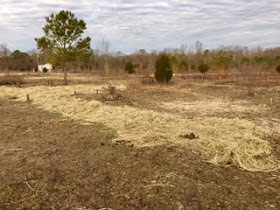From the moment of its birth a horse is on a constant search for security. That drive to be safe is what kept them alive for thousands of generations in the wild. The first security that a foal finds is from physical contact with its mother. It will never stop needing that contact and the best way to become close to your horse is to shower him with physical contact.
Horses form alliances with each other through physical contact. Comet, the appaloosa, is the lead horse in his band. Holland, the bay Shackleford Colonial Spanish mustang is his second in command. As other horses rise in status in the band they will copy this behavior. Given enough time and space the band will nearly always work out their conflicts so that the lower ranking horses feel secure in the presence of the lead horses.
Sometime this affection is misread by people. Their skin is very tough. Horses do not like to be tickled by super soft strokes. They seek out the same kind of strong contact that they remember their mothers giving them when they were foals.
The key to natural horsemanship is to adjust one's behavior and body language so that horses can understand it. Your physical contact with your horse is most appreciated when it feels natural to him.
When you rub him as a friendly horse would rub him you give that horse a tremendous sense of peacefulness. Note how the physical contact here with Bell, a wonderful little white mule, is similar to how horses interact with each other. Do not make unnatural contact with them. Horses do not pat each other. They rub each other. Your horse might learn to stand still while you clap your hand against his neck, but he will not instinctively enjoy it. When you are making contact with your horse get very close to him. Do not stand back and stretch your claws out towards his neck like a mountain lion would. People often stand back because they are afraid of having their toes stepped on. The best way to keep your toes from being stepped on is to always be alert. Know where your feet are. Know where your horse's feet are and push him away if he is getting to close to your feet.
Dog's love treats. Treats are a great way to establish a relationship with a dog. The first lesson to learn about building a relationship with a horse is to always understand that your horse is not a dog. Dogs are predators. Predators love excitement. When you hug a dog there is a very good chance that the dog will become rambunctious and playful. Horses are prey animals. They do not like excitement. When you hug a horse there is a very good chance that the horse will relax and even look bored! That is not boredom. That is peacefulness.
There is nothing wrong with occasionally giving your horse treats, but if your entire relationship is based on those treats you have taught your horse that you are simply a food delivery system. Doing so does not teach your horse that he is safe with you. Doing so does not teach your horse that you are a leader. Doing so does not bring him a feeling of peacefulness.
Every time you are in your horse's presence you are training him. You are training him to feel safe in your presence or you are training him that your presence does not make him safe.
When a horse is being brushed he relaxes with the physical stimulation that he receives. Having his mane braided or decorated in other ways does not create that same relaxation. That does not mean that you should not braid manes or do other things to make him look beautiful to you. It does mean that you should not neglect brushing, rubbing and hugging. That is what he needs. He really does not care if his mane is braided.
Horses are tuned in to every sight, sound, and smell around them. That is how they survived in the wilderness. As night begins to fall the wind often dies down. They can hear better without that wind and they can identify and locate the sources of scents better as the humidity rises as night approaches.
Take him outside of his stable as the day ends. That is the very best time to give your horse what he really wants. That is the perfect time to go stand so close to his shoulder that the two of you are touching each other. Completely relax your body. Be still. Notice his breathing. Breath in rhythm with him. Notice that his breathing is slowing. Watch his head lower a bit. Watch his ears relax. Watch him look as if he is so bored that he is about to fall asleep.
Spend at least a half an hour like that with him.
And understand why he is enjoying this experience more than anything else that has happened that day.













